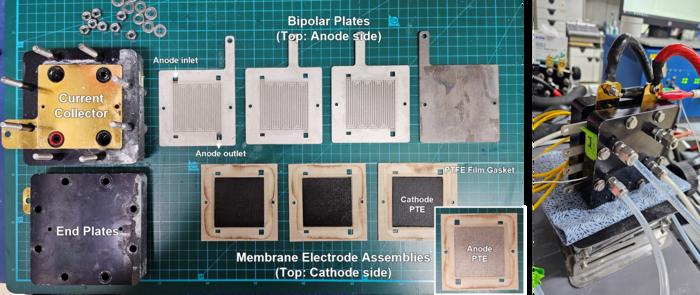Hydrogen, hailed as a clean energy vector, is pivotal to the global transition toward carbon neutrality. Traditional methods of water electrolysis, while promising, hinge heavily on expensive and structurally delicate catalyst layers, typically involving rare and precious metals such as iridium, ruthenium, or platinum to facilitate the oxygen evolution reaction (OER). These catalysts, although efficient, pose considerable cost and durability challenges, limiting their scalability and long-term application. The SNU team’s approach challenges this paradigm by introducing an electrochemical method that activates standard, commercially available nickel electrodes without any special catalyst coatings.
Central to this breakthrough is a process termed Electrochemical Activation (EA) operation. Instead of relying on chemically engineered catalyst layers, the EA operation manipulates the electrode’s electrochemical environment through a controlled dynamic polarization regimen. By intermittently applying a weak reducing voltage to the nickel electrode immersed in a potassium hydroxide (KOH) electrolyte containing trace iron ions, the system induces the selective reattachment of dissolved iron species onto the electrode surface. This reattached iron integrates with the nickel, spontaneously forming an active oxygen evolution catalyst layer that renews itself continuously, effectively making the electrode self-healing.
.adsslot_CgWjMZfUB2{ width:728px !important; height:90px !important; }
@media (max-width:1199px) { .adsslot_CgWjMZfUB2{ width:468px !important; height:60px !important; } }
@media (max-width:767px) { .adsslot_CgWjMZfUB2{ width:320px !important; height:50px !important; } }
ADVERTISEMENT
This dynamic polarization control method addresses one of the most critical bottlenecks in water electrolysis: the longevity and stability of the catalyst layer during operation. Conventional catalysts suffer performance degradation caused by structural transformations, dissolution, or detachment from electrode surfaces, necessitating frequent replacements or complex refurbishments. The self-sustaining catalyst layer formed on the nickel electrode remarkably retains its activity, enabling stable operation for over 1,000 hours at high current densities (approximately 1 A/cm²), demonstrating durability that meets industrial benchmarks.
Another key advantage lies in the use of widely available nickel metal and the natural occurrence of soluble iron impurities in alkaline electrolytes. The system converts what might traditionally be considered contaminants into functional components of the catalytic interface. This ingenious utilization of simple electrochemical principles and materials science heralds a shift toward more sustainable and cost-effective hydrogen generation technologies.
The economic implications of this innovation are significant. By eliminating reliance on precious metals and reducing fabrication complexity, green hydrogen production could become competitively priced against fossil fuel-derived hydrogen and other energy carriers. This advancement aligns with global ambitions to develop hydrogen economies, reduce greenhouse gas emissions, and build resilience through energy diversification.
Professor Jeyong Yoon, emphasizing the broader impact of their findings, pointed out that catalyst-free hydrogen production strategies represent a turning point for scalable and affordable hydrogen economies. The research is not just a laboratory curiosity but a practical blueprint for transformative energy technologies that can accelerate the decarbonization of various sectors, from transportation to chemical manufacturing.
Co-lead researcher Professor Jaeyune Ryu noted that this work integrates thorough electrochemical characterization with engineering perspectives. The study systematically clarifies the complex interplay of electrode and electrolyte processes and translates them into a robust, operable system, marking an important interdisciplinary milestone. This melding of fundamental science with application reinforces the critical value of bridging theoretical understanding and industrial relevance.
Looking ahead, the team envisions further optimizing the electrode activation protocols and exploring the longevity of the catalyst system under varying operational stresses and real-world conditions. Moreover, opportunities exist to extend the dynamic polarization approach to other electrode materials and electrolytes, potentially broadening the scope of affordable, catalyst-free electrochemical energy conversion technologies.
One of the study’s notable contributors, Dr. Sanghwi Han, intent on advancing carbon-neutral technologies, will continue his research in top-tier academic environments and aspires to empower Korea’s energy and environmental sectors through future academic and industrial leadership roles. Such international collaboration and capability building will be instrumental in translating pioneering discoveries like this into tangible societal benefits.
This research, appearing in the prestigious journal Nature Communications, was supported by multiple grants from the National Research Foundation of Korea and the Institute for Basic Science. Its scientific impact and promising practical implications are expected to fuel rapid follow-up studies, technology transfer initiatives, and commercial endeavors aimed at the widespread adoption of green hydrogen.
In essence, the dynamic polarization control approach devised by the Seoul National University team could dramatically reshape the cost and accessibility landscape of sustainable hydrogen production. By marrying electrochemical ingenuity with pragmatic engineering, this innovation stands to play a pivotal role in achieving carbon neutrality and establishing hydrogen as a cornerstone of future clean energy infrastructures.
Subject of Research: Not applicable
Article Title: Dynamic polarization control of Ni electrodes for sustainable and scalable water electrolysis under alkaline conditions
News Publication Date: 23-May-2025
Web References: http://dx.doi.org/10.1038/s41467-025-60201-w
Image Credits: © Seoul National University College of Engineering
Keywords
Green hydrogen, water electrolysis, nickel electrodes, dynamic polarization control, electrochemical activation, oxygen evolution reaction, catalyst-free hydrogen production, alkaline water electrolysis, self-healing electrodes, sustainable energy, carbon neutrality, scalable hydrogen technology
Tags: alkaline water electrolysis innovationscarbon neutrality advancementscost-effective electrolysis strategiesdurable hydrogen production methodsdynamic polarization control techniqueelectrochemical activation processeliminating precious metal catalystshydrogen energy sector breakthroughsnickel electrode applicationsrenewable energy research developmentsSNU water electrolysis technologysustainable green hydrogen solutions





